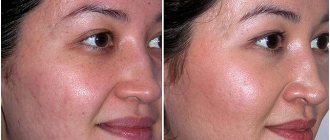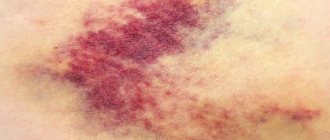Why does itching and rash occur?
The appearance of itching and rash, as a rule, is caused by various microorganisms that can live in both sea and fresh water. “Rashes accompanied by itching, burning or pain often occur both on the sea coast and when swimming in a freshwater body,” says Yuri Khaliulin, allergist, immunologist, dermatovenerologist of the European Medical Center, PhD, associate professor. - Of course, there is a greater chance of having unpleasant skin manifestations in swimming areas that are not an official beach, where wild or domestic animals come, and where the bottom of the reservoir has not been explored.
This is associated with the possibility of contamination of water and soil on the shore and, accordingly, an increased risk of infection.” Microorganisms can infect the skin both in water and on the shore. “Disease pathogens can be on the surface of the shore or in the water, and it is easier for them to invade if a person walks along the shore barefoot, especially if there is damage to the skin of the feet. Concomitant diseases that lead to decreased immunity are important,” adds Yuri Khaliulin. “The “offenders” can be very diverse: marine or freshwater inhabitants, microbes, parasites, and occasionally fungi.”
Let's take a closer look at them.
Rules for safe summer swimming for children and their parents
Dive and swallow water
Let’s be clear right away: there are no absolutely clean bodies of water.
Even in the bluest sea you can find E. coli, enteroviruses, rotavirus infection, the causative agent of dysentery, and much more - even Vibrio cholerae. All this survives perfectly both in fresh water and in salt water - it is not true that pathogens die in sea water, and the sea instantly cleanses itself, no matter what gets there. The likelihood of becoming infected with something unpleasant while swimming depends on the type of body of water (in ponds, lakes, rivers with a small current the risk is higher), on the concentration of swimmers (the more, the worse), on the volume of water (which is why the sea is considered a safer place for swimming ) and its water temperature, etc. Pediatricians advise teaching a child not to swallow water when swimming, and if there is the slightest doubt about the cleanliness of a reservoir, not allowing him to dive there, because in this case the risk of water getting inside is higher. But to contract any infection, drinking water is not necessary - the pathogen can enter the body through the mucous membranes, for example, of the nose or eyes. This happens all the time when bathing and there is no particular tragedy in it, because a healthy child’s immune system will most likely cope with it. What to do? Nothing. There is no reason and no particular point in giving a child who drank water while bathing any sorbents or doing anything else for prevention.
A rash appeared after swimming
It is impossible to become infected with scabies, pediculosis or a fungal infection in water if the skin is in good order.
But there is such a thing as swimmer's itch. Some time after swimming in a pond, lake or quiet river creek, red rashes appear on the skin, which can itch quite severely. This is how cercariasis manifests itself - a disease caused by parasite larvae carried by waterfowl. It is with this that the recommendation of sanitary doctors not to swim in bodies of water where ducks, geese, seagulls or swans are found. It is worth paying attention to aquatic plants - where there are a lot of them and there are snails, cercariae are probably also present. The risk of contracting cercariasis is higher when swimming within populated areas. What to do? If swimming in a place where cercariae can be found does take place, on the shore you should, if possible, rinse your body with clean water or at least wipe yourself dry with a towel. There is no specific treatment for cercariasis - fortunately, it is not dangerous; antihistamines and antipyretics can be used to relieve itching if the body temperature rises.
Water got into my ears
One of the main parental fears associated with bathing children is that water will get into their ears when diving and they will get sick. In fact, the first is unlikely, and the second is completely unnecessary if a healthy child is diving. Water cannot penetrate inside the ear - only into the external auditory canal, since it is protected by the eardrum. When it seems that something is “gurgling” inside and there is congestion, this means that there is not water in the middle ear area, but inflammation.
Parents often associate the occurrence of otitis externa (pain and itching in the ear after swimming; another name for this problem is swimmer’s ear or diver’s otitis) with cold water. In fact, there is no connection, rather the opposite - the warmer the water, the higher the risk, because inflammation of the external auditory canal is caused by pathogenic microflora. The higher the water temperature, the greater it is. It’s just that otitis media does not develop from periodic contact with water, just as sinusitis is not a consequence of water getting into the nose. The real reason is infection.
What to do? After bathing, it is enough to blot your ears with a towel as deep as possible to free the external auditory canal from water. The maximum is to jump alternately on one and the other leg. Under no circumstances should you rub your ears or reach inside with cotton swabs, trying to remove water - this risks microdamage, and therefore the penetration of pathogenic microorganisms inside. By the way, earwax, which parents are so eager to rid their children of, is actually a protective layer that actually reduces the risk of otitis externa.
In the summer - eternal otitis media: do I need to get tested and what kind?
Children are naturally prone to otitis media due to the structure of the ear canal.
But still, recurring inflammations, due to which some parents generally forbid approaching any water, are not the norm and require clarification of the real cause. What kind of research allows this to be done, says Oleg Volodin, head of the microbiology department of the laboratory of personalized medicine LabQuest: - Otitis, including recurrent ones, can be caused by a variety of microorganisms - pneumococcus, Haemophilus influenzae, Pseudomonas aeruginosa, Staphylococcus aureus, etc. It can be found in the ear and microflora of the skin, which are normally non-sterile, and when the immune status is reduced, sometimes even fungal flora is sown.
The most accurate cause of frequent otitis can be identified using bacterial culture from the external auditory canal with determination of sensitivity to antibiotics. This is a fairly fast and accurate study. False negative results are possible, but they are usually associated with incorrect sampling of the material - this requires sufficient qualifications of a nurse or otolaryngologist.
In case of recurring otitis, it makes sense to take a culture from the nasopharynx, since inflammation, for example, of the middle ear can be secondary to inflammatory diseases of the upper respiratory tract.
Skin diseases that may occur after swimming in fresh water
Of course, swimming in not every pond and lake is fraught with these diseases, but you should still be wary of them.
Leptospirosis occurs among lovers of water tourism, and is caused by microbes from the class of spirochetes. Other names for this disease are pretibial fever, Fort Bragg fever, ictero-hemorrhagic fever, Vasiliev-Weil disease. “Leptospirosis occurs infrequently, but is common in all regions except the Arctic. Infection occurs by penetration through damaged skin upon contact with contaminated soil near the shore of a river or lake, says Yuri Khaliulin. — Two to three days after infection, inflammation of the skin of the legs, high fever, headaches, nausea and vomiting, and conjunctivitis occur. Jaundice may develop due to damage to the liver and spleen. Inflammation of the heart muscle may develop. Treatment is based on antibiotics.”
Schistosomiasis. The disease occurs in Africa, the Middle East, the Caribbean, South America, China, Indonesia, and the Philippines. “Skin manifestations of schistosomiasis initially manifest as mild itching and papular rashes on the feet and other areas of the skin after swimming in polluted bodies of water containing cercariae (floating larvae of parasitic flatworms). The parasites that cause this disease penetrate the venous bloodstream of the human bladder or intestines, warns Yuri Khaliulin. — After an asymptomatic incubation period, a sudden illness may develop with fever and chills, pneumonia. The rash most often occurs on the skin of the genitals, perineum and buttocks. Vegetating soft masses, fistulas, extensive hard masses are accompanied by serous-purulent discharge.”
As a rule, schistosomiasis is treated with antiparasitic drugs.
Dermatitis caused by blood-sucking insects. Not only people like to relax near the water, but also blood-sucking insects - horseflies, mosquitoes.
“After a bite, itchy rashes remain due to the toxins released into the blood. In some people, the rashes are very persistent and large, which depends on the individual reaction of the immune system,” says Yuri Khaliulin. - In order to make these itchy rashes go away faster, in mild cases you can use gels with an antihistamine. But in case of a severe reaction, this gel will not help much. Then it is preferable to use an ointment containing a strong corticosteroid with an antibiotic. And take a second-generation antihistamine orally for several days.”
External repellents can help avoid or reduce the likelihood of being bitten by these insects.
Skin diseases that may occur after swimming in the sea
Many people believe that harmful microorganisms simply do not live in salt water. This is wrong. Here is a list of skin diseases that can develop after swimming in the sea.
Black mycosis ( tinea nigra ) is found in the tropics, along the gulf coast. “The disease is caused by the fungus Hortea werneckii. Brown or black spots appear on the skin of the feet or hands. This rash can be mistaken for a mole or melanoma. However, this disease is quite harmless and brings a person more of an aesthetic problem than an impact on health. It can be treated with external antifungal drugs,” adds Yuri Khaliulin.
Infection caused by the microbe vibrio vulnificans is characteristic of the Atlantic coast. Skin damage is possible when an open skin wound comes into contact with contaminated seawater. “The disease is acute. After a day or two, skin redness, swelling, hemorrhagic blisters and ulcers, and high body temperature appear. Necrosis of surrounding tissues may develop. Treatment is antibiotics, surgical excision of the affected tissue,” says Yuri Khaliulin.
Another marine microbial infection, aeromonas hydrophilia , can invade a wound following a water injury, resulting in inflammation of the soft tissue at the site of injury. “Gangrene may develop. Cases of this infection have been described on the Black Sea coast, in particular in Bulgaria. Antibiotics are used in treatment,” warns Yuri Khaliulin.
Itching and rash can also occur as a result of contact with marine life. For example, jellyfish, physalia or cnidarians (jellyfish larvae). “Dermatitis also develops after skin contact with other sea creatures: sea anemones, corals, special tiny seaweed dermatitis, sea urchins,” says Yuri Khaliulin.
Do the sea and sun help with acne*?
Sea water is saturated with calcium, magnesium, potassium, and other substances that help in the process of getting rid of acne*. The salt it contains (35 g per 1 liter) has antiseptic and anti-inflammatory effects. It promotes wound healing and regulation of sebum secretion181.
Sea salt has exfoliating properties and helps open pores, which helps cleanse them. But the paradox is that the appearance of acne* after the sea can also be associated with exposure to salt. It can dry out the skin and disrupt its barrier functions, so after the sea it is important to thoroughly wash off its residues from the body and face181.
Skin diseases that can develop after swimming in any body of water
Doctors also identify a group of skin diseases that can be contracted in any body of water or even a swimming pool.
Swimming pool granuloma. It is caused by an atypical mycobacterium, micobacterum marinum. “Infection is possible in both sea and fresh water. Infection occurs in lakes or on the shore of a lake or lagoon, or when working with aquariums, when the skin is damaged, in particular from fish fins. Some time after infection, a slowly developing, painless redness and thickening occurs at the site of infection. The infection may spread along the lymphatic tract and various complications, including damage to the ligaments and bones,” warns Yuri Khaliulin.
Cercarial dermatitis manifests itself as a very itchy, widespread rash. “Its appearance is caused by parasites, cercariae, whose hosts are animals, waterfowl and rodents. During swimming, colorless microorganisms, slightly less than 1 mm in size, attach to the skin, says Yuri Khaliulin. “Unlike schistosomiasis, they die in the skin and cannot enter the bloodstream or deeper tissues. Upon leaving the water, a person feels itchy and an erythematous rash appears, which disappears after a few hours. And after 10-15 hours, the symptoms resume, and erythematous spots and papules develop on the entire surface of open areas of the body that were in the water. Spontaneous recovery occurs after a few days.”
You can reduce the risk of disease if you take a shower after swimming in a pond and thoroughly dry your skin with a towel.
Creeping rash (larva migrans) is found in all tropical and subtropical countries. “Those who walk barefoot on the beach can become infected with this parasitic infection. The feet are most often affected. A rash in the form of a migrating convoluted subcutaneous cord appears 4 days after infection. The larva does not infect human internal organs. This disease is treated with antiparasitic drugs,” says Yuri Khaliulin.
How to prevent skin diseases after swimming?
In some cases (as with cercariasis), it is enough to simply take a shower after bathing and vigorously rub the skin with a towel. But the most reliable way to prevent skin diseases is simply not to visit “unverified” swimming places. “Measures to prevent various injuries from aquatic life include resting on a clean beach where swimming is allowed, wearing shoes on the beach if you are not going to go into the water, and using repellents,” adds Yuri Khaliulin.
If inflammation of the skin develops after being near water, you should consult a doctor if possible.
Using Clindovit® gel during a seaside holiday
It is impossible to say for sure whether the sun will help with acne* or, on the contrary, will provoke an exacerbation of acne. If you suffer from acne, consult your dermatologist before traveling to the seaside. You may need to review the list of medications you are using and choose a product with a higher SPF level.
There are a number of anti-acne products that have a photosensitizing effect, that is, they can cause a negative reaction when exposed to ultraviolet radiation. This side effect is indicated in the instructions. Clindovit® gel is not one of these drugs. It contains clindamycin phosphate, which upon contact with the skin is hydrolyzed to form clindamycin6. Dermatologists may prescribe the drug for mild to moderate acne6,18. Clindovit® gel has no contraindications for use in summer6.
*acne











